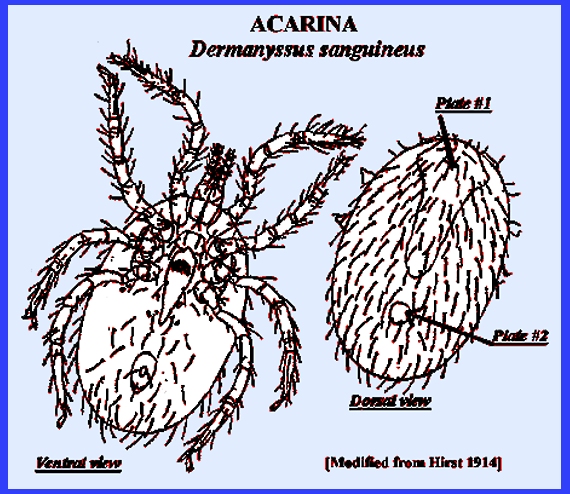File: <rickettsiae.htm> <Medical
Index> <General Index> Site Description Glossary <Navigate
to Home>
|
RICKETTSIAE (Contact) Please CLICK on
underlined links for details: The
cosmopolitan rat mite, Liponyssus bacoti transmits
a virus disease to humans and animals.
This mite has a very short life cycle that takes only about 12 days
(Dove & Shelmire 1931). Service
(2008) reported that transovarial and transstadial transmission can occur in
tick vectors. Other important kinds
of typhus are discussed separately according to the localities where they
occur. = = = = = = = = = = = =
= = = = = = = = Key References: <medvet.ref.htm> <Hexapoda> Camicas, J. L., J. . Hervy, F. Adam & P. C.
Morel. 1998. The ticks of the world (Acarida,
Ixodida): Nomenclature, Described
Stages, Hosts,
Distribution. Paris: Editions
de l'ORSTOM. CDC.
2005. Tularemia transmitted by
insect bites. Wyoming 2001-2003 MMWK
Weekly 54(7): 170-3. Dove, W., E. & B. Shelmire. 1931.
Tropical rat mite, Liponyssus
bacoti Hirst, vector of endemic typhus. J. Amer. Med. Assoc. 97:
1506-10 Dumler, J. S. & D. H. Walker. 2005.
Rocky mountain spotted fever: changing ecology and persisting virulence. New England J. of Medicine 353: 551-53. Ewing, H. E.
1923. Our only common North
American chigger, its distribution and nomenclature. J. Agr. Res. 26: 401-03. Gammons, M. & G. Salam. 2002. Tick
removal. Amer. Fam. Physician 66: 643-45. Gothe, R., K. Kunze & H. Hoogstraal. 1979.
The mechanisms of pathogenicity in the tick paralyses. J. Med. Ent. 16: 357-69. Hoogstraal, H.
1966. Ticks in relation to
human diseases caused by viruses.
Ann. Rev. Ent. 11: 261-308. Hoogstraal, H.
1967. Ticks in relation to
human diseases caused by Rickettsia
species. Ann. Rev. Ent. 12: 377-420. Huebner, R. J., W. L. Jellison &
C. Pomerantz. 1946. Rickettsial pox. IV. Isolation of a Rickettsia apparently identical with the
causative agent of
rickettsial pox. U. S. Pub. Hlth.
Repts. 61: 1677-1682. Lane, R. S., J. Piesman & W. Burgdorfer. 1991.
Lyme borreliosis: relation of its causative agent to its vectors and
hosts in North America and
Europe. Ann. Rev. Ent. 36: 587-609. Legner, E. F. 1995. Biological control of Diptera of medical and veterinary
importance. J. Vector Ecology 20(1):
59_120. Legner, E. F. 2000.
Biological control of aquatic Diptera. p. 847_870.
Contributions to a Manual of Palaearctic Diptera, Vol.
1, Science Herald, Budapest. 978 p. Matheson, R. 1950.
Medical Entomology. Comstock
Publ. Co, Inc. 610 p. Needham, G. R. & P. D. Teel. 1991.
Off-host physiological ecology of ixodid ticks. Ann. Rev. Ent. 36: 313-52. Parola, P. & D. Raoult. 2001. Tick-borne
typhuses. IN: The Encyclopedia of arthropod-transmitted
Infections of Man and Domesticated Animals. ed. M. W. Service, Wallingford: CABI: pp. 516-24. Service, M.
2008. Medical Entomology For
Students. Cambridge Univ. Press. 289 p Sonenshine, D. E., R. S. Lane & W. L. Nicholson.
2002. Ticks (Ixodida). IN:
Medical & Veterinary Entomology, ed. G. Mullen & L.
Durden,
Ambsterdam Acad. Press.
pp 517-58. Sonenshine, D. E. & T. N. Mather (eds.) 1994.
Ecological Dynamics of Tick-Borne Zoonoses. Oxford Univ. Press, New York. Steer, A., J. Coburn & L. Glickstein. 2005.
Lyme borreliosis. IN: Tick-Borne Diseases of Humans, ed. J. L.
Goodman, D. T. Dennis & D. E. Sonenshine. Washington, DC: ASM Press. |
